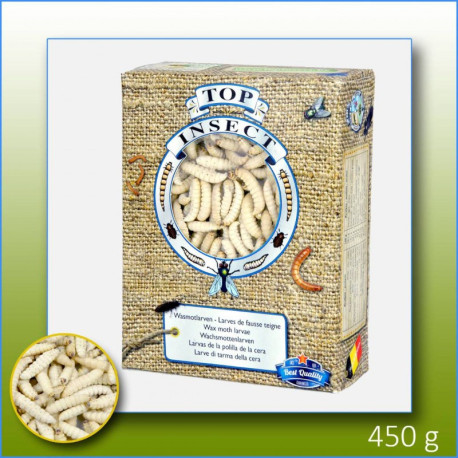



Reference: TEIGNE-DE-RUCHES450
Please note that for orders shipped to countries outside of Europe, additional taxes, customs duties, and fees may apply upon arrival in the destination country.
These charges are the responsibility of the customer and are determined by the local customs authorities.
We recommend checking with your local customs office for more information on potential charges before placing your order.
Frozen insects - Pick-up from the store only
Rich in dry matter and lipids, the larvae of false Topinsect moth are particularly nourishing. Very soft, they are easy to absorb and digest.
In breeding, false ringworm larvae are grown on a partially natural basis including honey bee honey and partially artificial, without any addition of growth stimulators or other chemicals. Since its breeding is laborious, it is a relatively expensive feeding insect.
As a result of de-bubbling and shock freezing processes provided by our own facilities, false ringworm larvae free of any bacteria are virtually sterile. The residual fraction of bacteria and mould is well below the standards in force for human and animal food. Frequent checks supported by analyses ensure careful monitoring of the entire procedure. This double treatment makes the larvae even more digestible.
The larvae of false ringworm (Galleria Mellonella (Linnaeus)) are the sworn enemies of the so-called "weak" hives, that is, where swarms are housed on a number of frames too high in relation to their population. They attack the rays, feed on wax and can affect virtually any material.
The life cycle of the great false ringworm consists of four stages: egg larva pupa moth.
The larval egg phase lasts between six and seven weeks, at a temperature of 30 degrees and a humidity level of 75 to 80 percent. Larval development is divided into seven successive stages and it is in the last two that growth is most important. Once mature, the larvae weave their cocoon and turn into a pupa from which the moth will be born.
ANALYSIS
% OF TOTAL MOTH LARVAE
Liquid 58.5
Dry matter 41.5
Crude ash 0.6
Protein 14.1
Fat 24.1
Carbohydrate 2.7
Starch 0
%ON DRY MATERIAL LARVAE OF MOTHS
Crude ash 1.4
Protein 34.0
Fat 58.0
Carbohydrate 6.6